非谓语动词公开课教学设计
高中英语《非谓语动词》优质课教案、教学设计
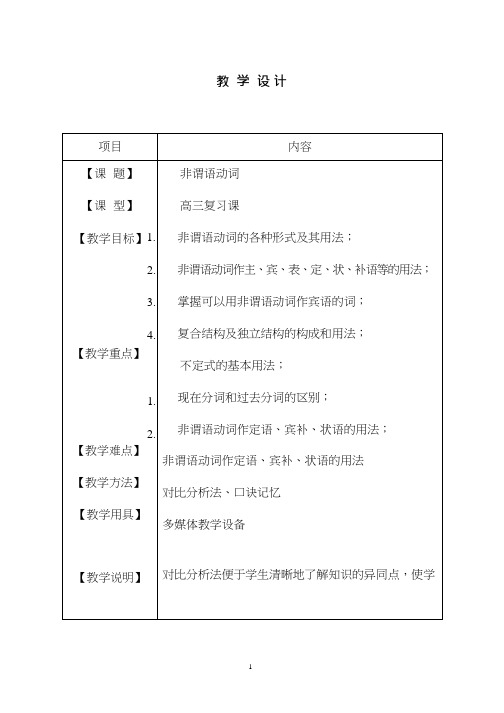
教学设计生能够从整体上把握知识脉络。
通过口诀记忆,使学生快速掌握,不容易遗忘。
在教学过程中,通过提问、启发等方式师生共同完成知识脉络,以达到较牢固的记忆及较理想的复习效果。
非谓语动词经常出现在高考题的语法填空、短文改错中,教学过程中的精选习题有助于学生及时地更好地掌握这部分语法知识。
【教学过程】课前预习(12 个单句语法填空)设计意图:通过练习,总结非谓语动词的形式,使学生对本节课的内容有大概的了解。
一、高考考纲解读近三年高考主要考查非谓语动词的作用和形式。
在作用方面主要考查作宾语时用不定式还是动名词;作宾语、状语、补语时用不定式还是分词;它们作某一成分时的特殊情况及特殊结构。
在形式方面主要考查用一般式还是完成式、主动式还是被动式、现在分词还是过去分词。
设计意图:使学生明确教学大纲的要求,了解其在考试中的重要性。
二、非谓语动词考点(二轮复习专家解读)1.不定式作宾语与动词的-ing 形式作宾语的区别2.不定式作宾补vs.分词作宾补的区别3.不定式作状语和分词作状语的区别4.不定式、现在分词和过去分词作定语的区别5.不定式的主动式和被动式作定语的区别6.动名词的复合结构作宾语时的代词转化7.带to 不定式和不带to 不定式8.不定式符号的单独使用设计意图:使学生细化知识点,掌握重难点。
三、非谓语动词思维导图及图表结构(结合时态和语态)设计意图:运用思维导图,一目了然,帮助学生有效记忆。
四、非谓语动词的句法功能归纳考点一非谓语动词作状语1.动词不定式作状语2.分词作状语3.独立成分作状语易错警示某些动词的过去分词已经形容词化,且常用于一些系表结构中,此时这些过去分词只表示一种状态,作状语时不表示被动关系,其前不用being。
语法训练吧:1.As the light turned green ,I stood for a moment ,not ,and asked myself what I was going to do.A.moved B.moving C.to move D.being moved2.an important role in a new movie,Andy has got a chance to become famous.A.Offer B.Offering C.Offered D.To offer考点二非谓语动词作定语1.过去分词作定语:2.现在分词作定语:3.动词不定式作定语:4.现在分词与动名词作定语的区别:语法训练吧:1.The idea you thought of a bridge over the river there sounds reasonable.A.build B.to build C.building D.built2.The ability an idea is as important as the idea itself.A .expressingB .expressedC .to expressD .to be expressed考点三非谓语动词作补语1.感官动词(词组)“一感”:f ee l“二听”:h ea r,li ste n to“五看”:see, watch, notice, observe, look at +宾语+1) 不带to 的不定式(表示主动和完成)2)现在分词(表示主动和正在进行)3)过去分词(表示被动和完成)2.make +宾语+do “让…做…”(与宾语为主动关系)make +宾语+done“让…被做”…”(与宾语为被动关系)3.let +宾语+do “让…做…”(与宾语为主动关系)let +宾语+be done“让…被做…”(与宾语为被动关系)4.have +宾语+do sth. 使…做某事have +宾语+doing sth. 使…持续做某事have+宾语+done 使…被做(宾语与宾补为逻辑上的被动关系)have sth. to do 有事要做(不定式作定语)注:have + sb. +doing 若用于否定句,不能容忍或不允许某人做某事。
非谓语动词课程设计
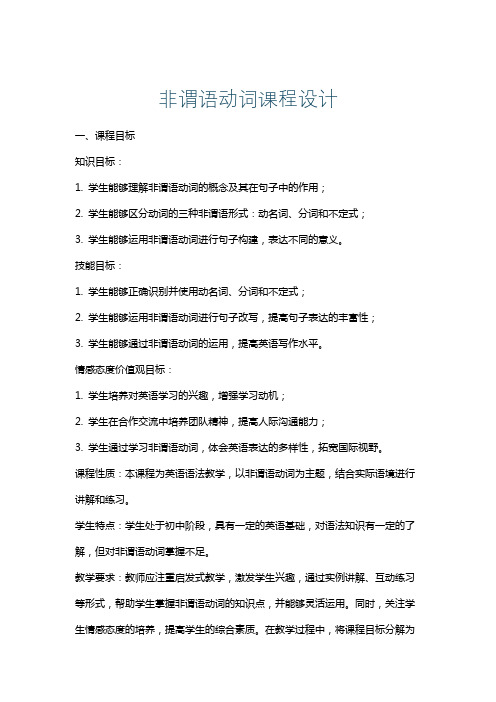
非谓语动词课程设计一、课程目标知识目标:1. 学生能够理解非谓语动词的概念及其在句子中的作用;2. 学生能够区分动词的三种非谓语形式:动名词、分词和不定式;3. 学生能够运用非谓语动词进行句子构建,表达不同的意义。
技能目标:1. 学生能够正确识别并使用动名词、分词和不定式;2. 学生能够运用非谓语动词进行句子改写,提高句子表达的丰富性;3. 学生能够通过非谓语动词的运用,提高英语写作水平。
情感态度价值观目标:1. 学生培养对英语学习的兴趣,增强学习动机;2. 学生在合作交流中培养团队精神,提高人际沟通能力;3. 学生通过学习非谓语动词,体会英语表达的多样性,拓宽国际视野。
课程性质:本课程为英语语法教学,以非谓语动词为主题,结合实际语境进行讲解和练习。
学生特点:学生处于初中阶段,具有一定的英语基础,对语法知识有一定的了解,但对非谓语动词掌握不足。
教学要求:教师应注重启发式教学,激发学生兴趣,通过实例讲解、互动练习等形式,帮助学生掌握非谓语动词的知识点,并能够灵活运用。
同时,关注学生情感态度的培养,提高学生的综合素质。
在教学过程中,将课程目标分解为具体的学习成果,便于教学设计和评估。
二、教学内容1. 动名词的介绍与运用- 动名词的定义与特点- 动名词的常见用法及例句分析- 动名词作主语、宾语、表语、定语的练习2. 分词的介绍与运用- 分词的定义与分类(现在分词、过去分词)- 分词的主动语态与被动语态- 分词作定语、状语的练习3. 不定式的介绍与运用- 不定式的定义与结构- 不定式作主语、宾语、表语、定语的用法- 不定式作目的状语、结果状语的练习4. 非谓语动词综合运用- 非谓语动词在句子中的位置与作用- 非谓语动词的省略与转换- 非谓语动词在复杂句子中的应用教学内容安排与进度:第一课时:动名词的介绍与运用第二课时:分词的介绍与运用第三课时:不定式的介绍与运用第四课时:非谓语动词综合运用(含练习与讲解)教材章节:本教学内容与教材中关于非谓语动词的章节相对应,涵盖动名词、分词、不定式的知识点。
英语非谓语动词经典教学教案.docx

非谓语动词( 6~8 分)第一讲:非谓语动词(一)教学目的:唤起学生对非谓语概念的理解,使学生掌握判断非谓语动词的方法和有关词汇的双重用法,掌握非谓语的三种形式。
教学重点:本节教学重点是判断非谓语动词的方法,有关词汇的双重用法;动名词的考点。
教学难点:掌握什么时候用非谓语教学过程:一、考情分析非谓语动词在专升本中是一个重要考点,属于每年必考容,主要考查分词做状语、定语和独立主格结构,和一些动词的固定搭配。
所谓非谓语动词是指不能作谓语的动词 (针对谓语而言 ),也不受主语人称和数的限制,但具有动词的某些特征。
它可以做主语、表语、宾语、宾补、定语、状语和同位语。
二、讲课过程基础知识补充动词的形式:五种基本形式(为了区别谓语与非谓语外加另外一种不定式形式)原形单三过去式eat eats ate(谓语动词形式:即可以单独作谓语)现在分词过去分词不定式eating eaten to eat(非谓语动词形式:不能作谓语)He eats an orange.( 主 +谓 + 宾)I eat an orange.( 主+ 谓+ 宾)I ate an orange.( 主+ 谓+ 宾)I am eating an orange.( 主 + 谓+ 宾)He has eaten an orange.( 主 + 谓+ 宾)An orange was eaten by him.( 主+ 谓+ 宾 )I am to eat an orange.( 主+ 谓 + 宾)含义:不能做谓语的动词1、什么时候用非谓语?一句话,有谓语,多动作,无连词Seen from the top of the mountain, our school looks so beautiful.2、形式:动名词(构成:动词原形+ing )分词(现在分词、过去分词)现在分词构成:动词原形+ing过去分词构成:动词原形+ed 或 done ;动词不定式基本形式:“to+ 动词原形”,有时可省去 to非谓语动词的形式如下 :一般式完成时进行时不定式主动to do to have done to be doing.被动to be done to have doneIng 形式主动doing having done被动being done havingbeendone过去分词被动完成done非谓语动词的否定形式:not + 不定式, not +动名词,not +分词非谓语动词的语法功能一、动名词主语: Reading is my hobby.宾语: I enjoy reading.表语: My hobby is reading.定语: He is in the reading room.二、现在分词表语: The book is interesting.定语: It's an interesting book.状语: He sat there, reading a newspaper.宾补: I saw him standing there.三、过去分词表语: They were excited at the news.定语: There are a few minutes left.状语: Seen from the hill, our school looks beautiful.宾补: I saw him beaten by Tom.四、不定式主语: To catch the train is impossible.宾语: They need to look at a map.表语: My work is to clean the classroom.定语: I have lots of work to do.状语: I am sorry to trouble you.宾补: He told me to close the door.考点动名词考点一:动名词作宾语的动词1.admit doing sth.承认做某事2.advise/suggest doing sth.建议做某事3.allow/permit doing sth.允许做某事4.appreciate doing sth.感激做某事5.avoid doing sth.避免做某事6.consider doing sth.考虑做某事7.delay/put off doing sth.推迟做某事8.deny doing sth.否认做某事9.like(enjoy)/dislike doing sth. 喜欢 / 不喜欢做某事10.escape doing sth. 逃脱做某事11.fancy doing sth.喜欢做某事12.finish doing sth.完成做某事13.forbid /prohibit doing sth.禁止做某事14.forgive doing sth.原谅做某事15.give up doing sth.放弃做某事16.imagine doing sth.想象做某事17.keep doing sth.保持做某事18.mention doing sth.提及做某事19.mind doing sth.介意做某事20.miss doing sth. 错过做某事21.practice doing sth.练习做某事22.prevent doing sth.阻止做某事23.report doing sth.报告做某事24.risk doing sth. 冒险做某事25.stop doing sth.停止做某事词组: devote to,get down to,be accustomed to confess to have trouble/difficulty (in)doing sth.例题: He enjoys ___ pop music while I prefer classical music.A. listen toB. to listenC. listeningD. listening to补充知识:及物动词:后面必须跟宾语的动词,像buy,reach,give 等。
非谓语动词(教案)

非谓语动词(教案)第一篇:非谓语动词(教案)非谓语动词(教案)在英语中,不是用作句子的谓语,而是用于担任其他语法功能的的动词,称之为非谓语动词。
非谓语动词有三种:不定式、动名词和分词。
一.非谓语动词与谓语动词之区别:1.相同之处:1)可以有宾语:He bought a house.He was considering buying a house.He wanted to buy a house.2)可以被状语修饰:He always gets up very early.He is used to getting up early.3)可以有“体”式和语态的变化:She has finished her job.Having finished her work,she went home.She is treated fairly.She insisted on being treated fairly.4)可以有自己的逻辑主语:My wife often works late.I dislike my wife’s working late.It was a hot day.It being a hot day, we stayed home.2.不同之处:1)可以起名词作用(如:不定式和动名词),在句中作主、宾、表语。
Your duty is to look after the plaining is no use.2)可以起形容词作用(如:不定式和分词),在句中作表语、定语和宾语补足语等。
The vase is broken.He is the a nice person to work with.We found the story amusing.3)可以起副词作用(如:不定式和分词),在句中作状语。
They are working hard to win still greater victory.The sick man came in, supported by two nurses.二.不定式:1.作主语(常置于句末,而用代替其做形式主语)T o learn a foreign language is not easy.It is not easy(for me)to learn a foreign language.2.作表语My job is to look after the babies.What I would like you to do is to keep silent about it.3.作宾语He offered to go with us.I want to see him.He considered ithis duty to support his family.作宾语补语(在see, hear, observe, watch, feel, notice等感官动词以及let, make,have等动词后面,作宾补的不定式 to均省去)They asked him to sing a pop song at the concert.They heard him sing a pop song in the meeting room.He was heard to sing a pop song in the meeting room.4.作定语Do you have anything to eat in your bag? He is always the first to come and the last to leave.5.作状语In order to save the the child, he dived into the river.We are overjoyed to see you.6.不定式的逻辑主语:I found it impossible for him to do the job alone.7.连接词+不定式He will tell me how to use the dictionary.Where to get the book is what I want to know.He didn’t tell us where to go and when to set out.8.不定式的否定形式They decided not to give up trying.9.不定式的时态We are happy to be with you on this trip.She is sure to succeed in the election.I’m sorry to be troubling you at such a time.I’m glad to be working with you.I’m sorry to have kept you waiting.The enemy was reported to have surrendered two days before.10.不定式的语态This book is said to have been translated into many languages.It is an honour for me to be asked to speak here.三.动名词:1.作主语Saying so much is useless/no good/(of)no use It is useless/no good/(of)no use saying so much.Reading French is easier than speaking it.2.作表语My hobby is collecting stamps.My great pleasure is learning English.3.作宾语(下列动词只能接动名词avoid, consider, deny, enjoy, escape,finish, mind, keep, practise, miss,regret, insist on, give up, put off, object to)He enjoys listening to classical music.We must avoid making such mistakes again.I wouldn’t mind waiting for another ten minutes.(有些动词后面可接动名词,也可接不定式:begin, start, continue, like, hate, prefer但动名词表示的意义是在一般情况下的行为,而不定式则表示某个具体的、一次性的行为。
初三非谓语动词讲解教案

初三非谓语动词讲解教案教案教学目标:1. 理解非谓语动词的定义和用法。
2. 掌握非谓语动词的三种形式:动词不定式、动名词和动词-ing 形式。
(to-不定式,-ing 动词形式)3. 能够正确使用非谓语动词来丰富句子结构和表达能力。
教学重难点:1. 非谓语动词的定义和用法。
2. 非谓语动词形式的变化。
3. 注意非谓语动词的逻辑主语与谓语动词的主语之间的关系。
教学准备:1. 教师准备一些例句和相关练习题。
2. 准备一个展示板或黑板。
教学过程:Step 1. 引入非谓语动词的概念(5分钟)教师可通过引入一些有趣的例子,引起学生的兴趣。
例如,小明喜欢游泳,小红喜欢唱歌。
然后问学生“游泳”和“唱歌”是什么词性,表示什么含义。
引导学生认识到“游泳”和“唱歌”不仅可以表示动作,而且可以独立作为名词,这就是非谓语动词。
Step 2. 介绍非谓语动词的三种形式(10分钟)教师在黑板上写下以下三种形式:动词不定式(to-不定式)、动名词和动词-ing 形式,并给出相应的例子进行解释和说明。
动词不定式:动词原形前加“to”,表示动作的未完成、将要发生或被动作所致。
例:to swim, to eat。
动名词:动词的现在分词形式,可以作主语、宾语、表语、定语、宾补等。
例:swimming, eating。
动词-ing 形式:动词的现在分词形式,常作主语、宾语、定语、表语等,表示正在进行的动作。
例:swimming, eating。
Step 3. 练习非谓语动词的形式变化(20分钟)教师给学生一些练习题,要求学生用适当的非谓语动词形式填空,以巩固所学知识。
1. I enjoy _____________ (read) novels.2. She likes _____________ (watch) movies with her friends.3. They are good at _____________ (swim).4. He wants _____________ (go) to the park tomorrow.5. We need _____________ (finish) our homework before dinner.Step 4. 注意非谓语动词的逻辑主语与谓语动词的主语之间的关系。
英语非谓语动词教案

英语非谓语动词经典教案一、教学目标1. 让学生掌握非谓语动词的基本概念和用法。
2. 培养学生正确运用非谓语动词表达句子的能力。
3. 提高学生英语写作和口语表达能力。
二、教学内容1. 非谓语动词的分类:动词不定式、动名词、分词。
2. 非谓语动词的用法和句型结构。
3. 非谓语动词在句子中的功能和作用。
三、教学重点与难点1. 非谓语动词的分类和区别。
2. 非谓语动词的固定搭配和用法。
3. 非谓语动词在复杂句子中的运用。
四、教学方法1. 讲授法:讲解非谓语动词的基本概念、用法和句型结构。
2. 案例分析法:分析典型例句,让学生直观地理解非谓语动词的用法。
3. 练习法:设计各种练习题,让学生巩固所学知识。
4. 互动法:鼓励学生积极参与讨论,提高口语表达能力。
五、教学安排1. 第1-2 课时:讲解非谓语动词的基本概念和分类。
2. 第3-4 课时:讲解非谓语动词的用法和句型结构。
3. 第5-6 课时:分析非谓语动词的固定搭配和用法。
4. 第7-8 课时:讲解非谓语动词在复杂句子中的运用。
5. 第9-10 课时:进行课堂练习和答疑。
6. 第11-12 课时:组织学生进行口语表达和实践。
7. 第13-14 课时:总结非谓语动词的重要知识点。
8. 第15 课时:进行课程复习和测试。
六、教学资源1. 教材:英语非谓语动词相关章节。
2. 课件:制作精美课件,辅助讲解非谓语动词的基本概念、用法和句型结构。
3. 练习题:设计各种练习题,包括选择题、填空题、改错题等,让学生巩固所学知识。
4. 视频资源:寻找相关英语非谓语动词的教学视频,供学生课后自主学习。
七、教学过程1. 导入:通过提问方式引导学生回顾谓语动词的相关知识,为新课的学习做好铺垫。
2. 讲解:详细讲解非谓语动词的基本概念、用法和句型结构,结合典型例句进行分析。
3. 互动:鼓励学生积极参与讨论,提问解答学生在学习过程中遇到的问题。
4. 练习:让学生完成练习题,检测对非谓语动词知识的掌握程度。
非谓语动词教案

非谓语动词教案非谓语动词教案一、教学目标:1. 了解什么是非谓语动词;2. 掌握非谓语动词的基本形式和用法;3. 能够正确使用非谓语动词进行句子构成;4. 培养学生对语法规则的运用能力。
二、教学内容:1. 了解非谓语动词的概念;2. 掌握非谓语动词的种类和形式;3. 学习非谓语动词的基本用法;4. 进行非谓语动词的练习。
三、教学步骤:Step 1:引入1. 教师通过图片和实物引入非谓语动词的概念,引发学生的兴趣;2. 教师向学生解释非谓语动词的定义和作用。
Step 2:知识点讲解与示范1. 非谓语动词的种类和形式:动词不定式、动名词、分词(现在分词、过去分词);2. 非谓语动词的基本用法:a. 动词不定式:用作主语、宾语、表语、定语等;b. 动名词:用作主语、宾语、表语等;c. 现在分词:用作定语、状语等;d. 过去分词:用作定语、表语、补语等;3. 教师通过例句和示范向学生讲解非谓语动词的用法;4. 教师设计一些例题,让学生进行翻译和填空练习,巩固非谓语动词的用法。
Step 3:学生练习1. 学生进行口头和书面的练习,完成一些非谓语动词的句子组织;2. 学生进行小组讨论,互相纠正和改正句子中的错误;3. 学生可以相互出题,让同学们进行回答。
Step 4:讲解与总结1. 教师对学生练习中遇到的问题进行解答;2. 教师对非谓语动词的用法进行总结,强调一些易错点和注意事项;3. 教师进行反馈评价,给予学生鼓励和奖励。
四、教学模式:1. 教师示范与学生练习相结合;2. 教师讲解与学生讨论相结合。
五、教学资源:1. 图片和实物;2. 教师PPT;3. 教材课本;4. 纸笔。
六、教学反思:1. 在设计教学活动时需要注意语言简洁明了,因为非谓语动词的概念和用法对学生来说比较抽象;2. 在讲解过程中需要尽量用简单的例子和语言来解释,帮助学生理解;3. 在练习环节中给予学生足够的时间去完成任务,让学生充分发挥自己的动手能力;4. 在总结阶段需要及时梳理和归纳学生的错误,并及时进行纠正和指导。
(完整版)非谓语动词公开课教案

3.Examples&
explanation
Present fournonfinite verbsentencesand explain them.
Guide students to get some techniquesand stepsinnonfinite verbexercise.
Master some skills on correctingthe verb errors.
8.Reading
Read some structures and keep them in mind.
Remembersome important structures.
9.Homework
1.Review whatyouhave learned in the lesson.
1.How to make students understand and use nonfinite verbscorrectly.
2.Develop students creativity to create their own ways to remember grammar rules.
VI.Teaching aids(教具):
Teaching Plan for
I.Lesson type(课型):Grammar lesson,areviewlesson.
II.Teachingaims(教学目标):
Enable studentsto understand and use the nonfinite verbscorrectlyin grammar filling and errors correction.
非谓语动词公开课英语教案
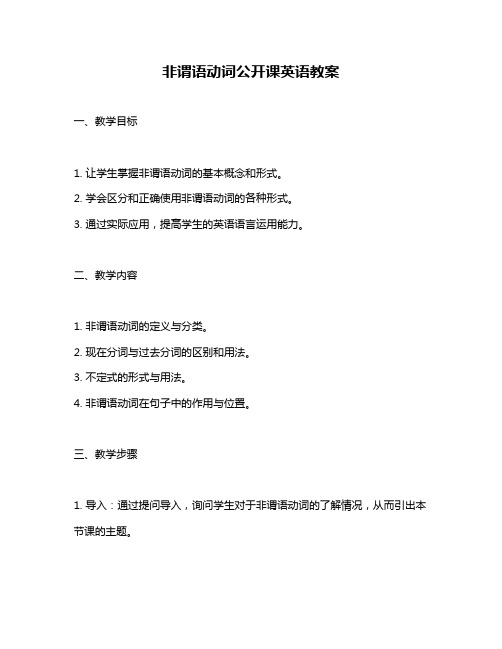
非谓语动词公开课英语教案
一、教学目标
1. 让学生掌握非谓语动词的基本概念和形式。
2. 学会区分和正确使用非谓语动词的各种形式。
3. 通过实际应用,提高学生的英语语言运用能力。
二、教学内容
1. 非谓语动词的定义与分类。
2. 现在分词与过去分词的区别和用法。
3. 不定式的形式与用法。
4. 非谓语动词在句子中的作用与位置。
三、教学步骤
1. 导入:通过提问导入,询问学生对于非谓语动词的了解情况,从而引出本节课的主题。
2. 定义讲解:介绍非谓语动词的基本概念,强调其作为句子中非谓语成分的存在,并区分其与谓语动词的不同。
3. 形式分类:详细讲解现在分词、过去分词和不定式的形式变化,让学生了解其基本构成。
4. 用法讲解:通过例句分析,让学生了解非谓语动词在句子中的用法,并学会区分现在分词、过去分词和不定式的不同用法。
5. 练习巩固:通过填空、选择、翻译等多种形式的练习,让学生实际操作,加深对非谓语动词的理解和记忆。
6. 总结回顾:对本节课所学内容进行总结,强调非谓语动词的重要性和在实际运用中的技巧。
7. 布置作业:要求学生收集相关的非谓语动词例句,并进行分类整理,加深对非谓语动词的理解。
四、教学反思
本节课通过系统的讲解和丰富的练习,使学生对非谓语动词有了较为全面的了解,但在实际运用中仍需加强练习,提高学生的语言运用能力。
在今后的教学中,应更加注重实际应用,让学生更好地掌握英语语言的运用技巧。
非谓语动词公开课教案
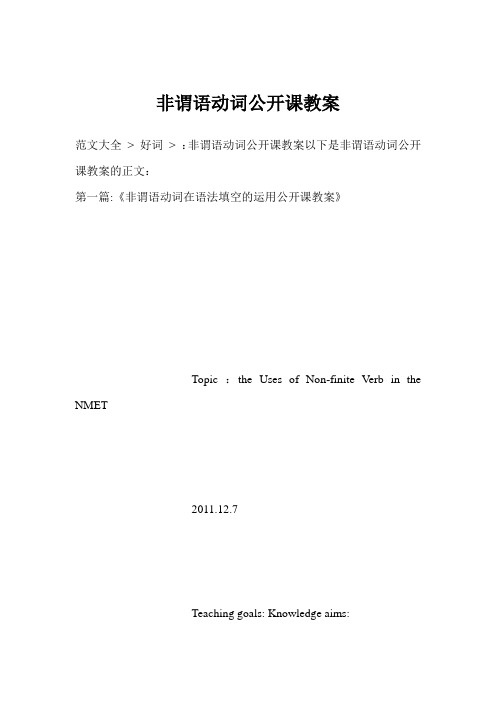
非谓语动词公开课教案范文大全> 好词> :非谓语动词公开课教案以下是非谓语动词公开课教案的正文:第一篇:《非谓语动词在语法填空的运用公开课教案》Topic :the Uses of Non-finite Verb in the NMET2011.12.7Teaching goals: Knowledge aims:1. Have Ss master the base structures of non-finite verbs2. Enable Ss to solve problems in the passage through the methods Ability aims:1. have Ss master the ability to analyse the structure of the sentence2. have Ss use the proper forms of non-finite verbs in the passage . Emotional aims:1. Improve students' tactical awareness such as self-study, cooperation study and research consciousness Teaching key points:1. Use the proper form of non-finite verb such as V-ing ; V-ed; to do Teaching difficult points:1.Find out the logical subject, the proper voice the correct tense2.How to use the proper form of non-finite verbs Teaching methods:1. analyse the structure of the sentence and make sure the non-finite verb2. find out the logical subject and use the proper voice such as active voice ,passive voice3. use the correct tense of the non-finite verb in the sentenceTeaching procedures:Lead in : Three steps to go1.分析句子结构2.确定非谓语动词在句中的成分和作用3.确定时态五种基本句型为基础:Step1 .分析句子结构[例1] I got on the bus and found a seat near the back, and then I noticed a man front. (2011广东卷)[例2] He spit it out, (say) it was awful. (2010广东卷)归纳:[例3]The fact that so many people still smoke in public places _______ that we may need a nationwide campaign to raise awareness of the risks of smoking.A. suggestB. suggestsC. suggestedD. suggesting [例3].用turn 的正确形式填空1. If you2.3.[例1] She wished that he was as easy (please)as her mother,who was always delighted with perfume.(2009广东卷)[例3] 用see 的正确形式填空(1)_______ from the top of the hill, our houselooks like a car. (2)_______ the dog came over, our friend ran away.(3)_______ from the top of a hill, and you’ll find the city more beautiful. (4)_______ more clearly, they came up and got close to it. (see) [例4] 用compare的正确形式填空1. When____________different cultures, we often pay attention only to the differences without noticing the similarities.2.__________ with other top students, you are better.Strp3.确定时间状态[例1] 用discuss的正确形式填空(1)The question _________________now at the meeting is very important. (2)The question at the meeting last week is very important.非谓语动词公开课教案(3)The question __________________ at the meeting next week is very important. (discuss) [例2]1._____many times , but he still couldn't understand it .2. _____many times , he still couldn't understand it . A. Having been told B. ToldC. He was toldD. To be told 再比较:1.He is the best one______( do) the job.2.He was considered the first man _______________( invent)the telephone.Step 4 :其他常见的用法[例1].I haven’t decided which hotel (stay)归纳:[例2]1. (lose)in thought, he almost ran into the car in front of him.2. (tire)of playing football, he went back to the classroom.3. (face)with difficulty, he rushed forward bravely. 有些过去分词源于系表结果,分词已经形容词化,相当于形容词:非谓语动词公开课教案[例3]非谓语动词公开课教案1. I woke early only find)it was still midnight.2.The output of iron decreased by 23%last year, reach)80,000 tons.归纳:[例4]1. The flowers smell)sweet in the garden attractthe visitors to the beauty of nature. Step5: 考点综合应用语篇填空,用所给动词的适当形式填空。
2024非谓语动词公开课教案

01课程介绍与目标Chapter公开课背景提高学生英语语法水平适应英语教学改革需求随着英语教学改革的深入,对非谓语动词的教学提出了更高的要求,本次公开课旨在探讨更有效的教学方法。
知识目标能力目标情感目标030201教学目标与要求教学内容与方法教学内容教学方法02非谓语动词基本概念Chapter定义及作用定义作用种类与形式动名词不定式由动词+ing的动作或状态,具有名词的性质。
分词与谓语动词的区别与联系区别联系03非谓语动词用法详解Chapter不定式(Infinitive)定义用法例子动名词(Gerund)定义动名词是动词的一种非谓语形式,具有名词的性质,可以在句子中充当主语、宾语等。
用法动名词表示一种抽象的行为或动作,常用于固定搭配和某些动词后。
例子I enjoy listening to music.(我喜欢听音乐)中的“listening”为动名词作宾语。
分词(Participle)定义用法例子04非谓语动词在句子中的位置和功能Chapter句首01句中02句尾03作主语非谓语动词可以作句子的主语,表示一个动作或状态。
例如,“To see is to believe.”(眼见为实。
)非谓语动词可以作句子的宾语,通常跟在动词后面。
例如,“I want to learnhow to cook.”(我想学习如何烹饪。
)非谓语动词可以作句子的表语,描述主语的状态或特征。
例如,“Themovie is exciting towatch.”(这部电影看起来很刺激。
)非谓语动词可以作句子的定语,修饰名词或代词。
例如,“The singingbird is very beautiful.”(唱歌的鸟儿非常美丽。
)非谓语动词可以作句子的状语,表示动作发生的时间、条件、原因等。
例如,“Having finished hiswork, he went home.”(完成工作后,他回家了。
)作宾语作定语作状语作表语与主语的关系非谓语动词与句子主语的关系可以是主动或被动。
非谓语微课优质课教案

非谓语微课优质课教案一、教学目标。
1. 知识目标,学生能够准确理解和运用非谓语动词的概念和用法,并能够在实际语境中正确使用非谓语动词。
2. 能力目标,培养学生的语言表达能力,提高学生的阅读理解能力和写作能力。
3. 情感目标,激发学生学习英语的兴趣,培养学生的自主学习能力和团队合作精神。
二、教学重点和难点。
1. 重点,非谓语动词的概念和用法。
2. 难点,非谓语动词在句子中的具体运用。
三、教学过程。
1. 导入(5分钟)。
通过播放一段有关非谓语动词的视频,引导学生了解非谓语动词的概念和用法,激发学生学习的兴趣。
2. 学习非谓语动词的概念和分类(10分钟)。
通过教师讲解和示范,让学生了解非谓语动词的概念和分类,包括不定式、动名词和分词。
3. 练习非谓语动词的用法(15分钟)。
让学生进行一些非谓语动词的练习,包括句子改写、填空和翻译等,巩固学生对非谓语动词的掌握。
4. 阅读理解(20分钟)。
让学生阅读一篇短文,并在阅读后回答相关问题,通过阅读理解的练习,帮助学生更好地理解非谓语动词的用法。
5. 写作练习(20分钟)。
让学生进行一些关于非谓语动词的写作练习,包括句子填空、翻译和段落写作等,培养学生的写作能力。
6. 总结(10分钟)。
通过教师总结和学生讨论,总结本节课的重点内容,强化学生对非谓语动词的掌握。
四、教学反思。
通过本节课的教学,学生能够初步理解非谓语动词的概念和用法,并能够在实际语境中正确使用非谓语动词。
同时,通过阅读理解和写作练习,学生的语言表达能力和阅读理解能力也得到了提高。
在教学过程中,教师需要注重激发学生的学习兴趣,引导学生自主学习,培养学生的团队合作精神,从而更好地达到教学目标。
非谓语动词公开课英语教案

03
Example
To see is to believe In this sentence, the infinitive "to see" and
"to believe" serve as the subject and predicate, respectively.
Gerund
Definition
02
Basic concepts of non finite verbs
Definition and Function
Definition
Non finite verbs refer to verb forms that do not act as predicates in a sentence. They are not limited by the person and number of the subject, have characteristics of other parts of speech, and can serve as other components of
The present participle is formed by adding - ing to the verb base form, indicating active and progressive meanings.
The sliming girl is my sister The smiling girl is my younger sister. In this sentence, the present participle "smiling" is used as an adjective to modify "girl".
非谓语动词公开课教案
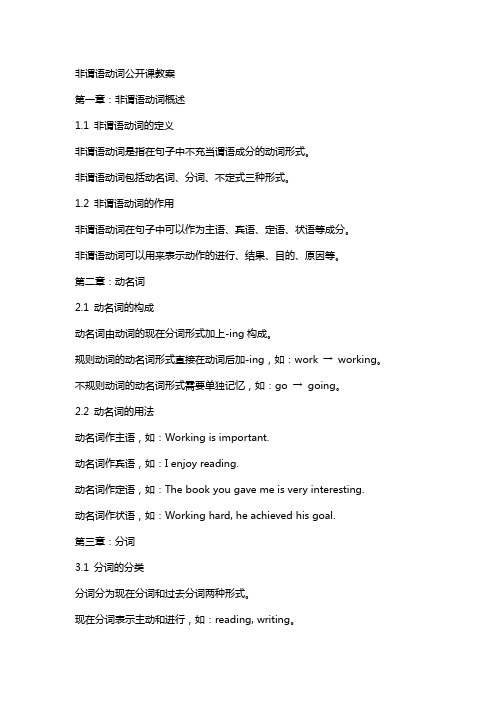
非谓语动词公开课教案第一章:非谓语动词概述1.1 非谓语动词的定义非谓语动词是指在句子中不充当谓语成分的动词形式。
非谓语动词包括动名词、分词、不定式三种形式。
1.2 非谓语动词的作用非谓语动词在句子中可以作为主语、宾语、定语、状语等成分。
非谓语动词可以用来表示动作的进行、结果、目的、原因等。
第二章:动名词2.1 动名词的构成动名词由动词的现在分词形式加上-ing构成。
规则动词的动名词形式直接在动词后加-ing,如:work →working。
不规则动词的动名词形式需要单独记忆,如:go →going。
2.2 动名词的用法动名词作主语,如:Working is important.动名词作宾语,如:I enjoy reading.动名词作定语,如:The book you gave me is very interesting.动名词作状语,如:Working hard, he achieved his goal.第三章:分词3.1 分词的分类分词分为现在分词和过去分词两种形式。
现在分词表示主动和进行,如:reading, writing。
过去分词表示被动和完成,如:written, cleaned。
3.2 分词的用法分词作主语,如:Reading is my hob.分词作宾语,如:I enjoy watching movies.分词作定语,如:The girl sitting next to me is my sister.分词作状语,如:Walking in the park, I saw a beautiful bird.第四章:不定式4.1 不定式的构成不定式由动词的现在分词形式加上-to构成,如:work →to work。
部分不规则动词的不定式形式需要单独记忆,如:go →to go。
4.2 不定式的用法不定式作主语,如:To learn English well is important.不定式作宾语,如:I want to watch a movie.不定式作定语,如:The book to read is on the table.不定式作状语,如:Going to the store, I bought some groceries. 第五章:非谓语动词的辨析与应用5.1 动名词、分词、不定式之间的区别与联系动名词表示一般性的动作或状态。
高中非谓语动词教案

高中非谓语动词教案【篇一:非谓语动词教案】(非谓语动词)period 1 infinitive(不定式)objectives1.to revise infinitive to get a better knowledge .2.to practice infinitive to grasp more .(非谓语动词——不定式、分词和动名词——在高中学习中是一个很重要的部分。
在每年的高考中,无论是全国卷还是省市卷都是必考部分,因此,对此部分的学习与掌握都是必要的。
考虑到其重要性以及内容较多,决定分部分进行全面复习,从基本概念入手,再从形式、功能、重难点等方面进行讲解,最后进行操练巩固,以达到复习的最佳效果。
) resources used grammar summary; the multimediai. revision and lead-in(复习与导入)show ss how important this part is.以2011年全国各省市高考卷中出现的非谓语导入。
ii. presentation(呈现)( on screen)归纳总结1 非谓语动词在句中所作的成分:归纳总结2 不定式的时态:不定式的语态(被动):归纳总结3 注意点:iii. practice(操练)高考链接1.(2011北京卷)25. it’s important for the figures _________ regularly.a. to be updatedb. to have been updatedc. to updated. to have updated2. (2011上海卷) 40. today we have chat rooms, text messaging, emailing… but we seem _____ the art of communicating face-to-face.a. losingb. to be losingc. to be lostd. having lost3. (2011浙江卷)19. if they win the final tonight, the team are going to tour around the city ______ by their enthusiastic supporters.a. being cheeredb. be cheeredc. to be cheeredd. were cheered4.(2011福建卷)27.the difference in thickness and weightfrom the earlier version makes the ipad 2 more comfortable____.a .held b. holding c. be held d. to hold5.(2011天津卷)7.passengers are permitted _____ only one piece of hand luggage onto the plane.a. to carryb. carryingc. to be carriedd. being carried6.(2011重庆卷)29.more tv programs, according to government to officials, will be produced _______people’s concern over food safety.a. to raiseb. raisingc. to have raisedd. having raised7 . (2011湖南卷)21 . the ability _____an idea is as important as the idea itself.a. expressingb. expressedc. to expressd. to be expressed8.(2011四川卷)11. simon made a big bamboo box _______ the little sick bird till it could fly. a. keep b. kept c. keeping d. to keep iv. language in use.(操练巩固—运用—提升)1.主语: 1.当今掌握一门外语真的很重要。
非谓语动词公开课课件教学设计

---------------------------------------------------------------最新资料推荐------------------------------------------------------ 非谓语动词公开课课件教学设计1 非谓语动词公开课教学设计一、教学设计(一)背景 1. 主题语境:非谓语动词是高中英语的重点语法项目,也是高考语法填空和短文改错的必考点。
本课在使学生了解非谓语动词的语法知识后,设计一系列的练习,从单句语法填空到单句改错,图片描述,到语篇运用填空,再到书面表达中的扩写句子,层层深入,为最终写作的应用做好铺垫。
且在写作操练中设定了环境保护这一个主题语境,不仅贴近当前社会生活实际,更重要的是能够让学生在练习使用非谓语动词的多种形式时,了解跟环境相关的知识,为学生提供运用知识的平台,从而把语言的语法形式、意义和运用有机地结合起来。
2. 语篇类型:本课设计以学生为中心出发,引导学生从词汇和句法上分析非谓语动词的语法形式,创设学习非谓语动词的形式的篇章语境。
然后通过口头陈述、观察例句、单句描述等活动为后续的篇章练习服务,深化对语篇语境的解读,努力使语言教学从碎片化走向整合化、情境化和结构化。
3. 授课时长:40 分钟(二)文本分析本课所选句子及篇章首先遵循从学生实际水平出发的原则,力求使学生在了解词汇掌握句子的情况下感知1 / 10非谓语动词的语法知识。
在此基础上,设计多样有趣的句子提升学生兴趣,调动课堂氛围,同时兼顾所选文本对社会主题知识的辅助作用。
(三)学情分析学生为高二文科普通班学生,虽学英语多年,但整体基础较为薄弱,且英语单词量严重缺乏,对高中语法知识没有深入了解。
因此,应特别注意导学案的难度深浅设计以及课堂教学方法的趣味性和多变性,尽量使学生能有兴趣主动参与到课堂中来。
(四)教学目标 2 基于新课标的要求,本节课的教学目标主要分为以下几点:1. :语言知识:通过本节课的学习,使学生能够初步了解什么是非谓语动词,会判断何时使用非谓语动词,并且能够在运用中选择使用正确的非谓语动词形式。
非谓语动词公开课讲课教案

2024/1/26
如果非谓语动词是带to的不定式,可 以在to前加上否定词。
17
否定形式的运用技巧
要根据句子的语境和 表达的意图来选择合 适的否定词和否定形 式。
在使用否定形式时, 要注意避免双重否定 的出现,以免产生歧 义或误解。
2024/1/26
要注意否定词的位置 和与非谓语动词的搭 配,确保语法正确、 表达清晰。
05
2024/1/26
04
条件状语
Given more time, we could have done it better.(如果给我们更多时间 ,我们可以做得更好。)
22
06
非谓语动词的省略现象
Chapter
2024/1/26
23
省略现象的种类及原因
种类
并列句中的省略:在并列句中,如果两个分句中的非谓 语动词逻辑主语相同,且动词形式也相同,则可以省略 后一个分句中的非谓语动词主语和动词。 语言的经济性原则:省略可以避免重复,使语言更加简 洁明了。
在学习过程中,我遇到了一些困难,如对某些搭配和惯用法的理解不 够深入,但通过反复练习和老师的讲解,我逐渐克服了这些困难。
2024/1/26
30
教师对学生学习情况的点评与建议
2024/1/26
学习成果
学生们通过本课程的学习,对非谓语动词有了较为全面的认识,能够正确运用非谓语动词 进行表达。
学习方法
学生们采用了多种学习方法,如听讲、记笔记、做练习等,这些方法有助于加深对知识的 理解和记忆。
Chapter
2024/1/26
15
否定词的位置及作用
否定词一般放在非谓语动词之前,用 于表达相反或否定的意义。
非谓语动词教案范文
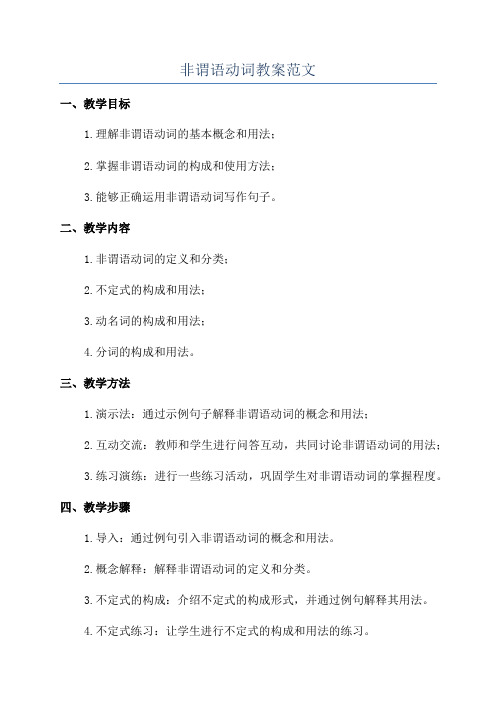
非谓语动词教案范文一、教学目标1.理解非谓语动词的基本概念和用法;2.掌握非谓语动词的构成和使用方法;3.能够正确运用非谓语动词写作句子。
二、教学内容1.非谓语动词的定义和分类;2.不定式的构成和用法;3.动名词的构成和用法;4.分词的构成和用法。
三、教学方法1.演示法:通过示例句子解释非谓语动词的概念和用法;2.互动交流:教师和学生进行问答互动,共同讨论非谓语动词的用法;3.练习演练:进行一些练习活动,巩固学生对非谓语动词的掌握程度。
四、教学步骤1.导入:通过例句引入非谓语动词的概念和用法。
2.概念解释:解释非谓语动词的定义和分类。
3.不定式的构成:介绍不定式的构成形式,并通过例句解释其用法。
4.不定式练习:让学生进行不定式的构成和用法的练习。
5.动名词的构成:介绍动名词的构成形式,并通过例句解释其用法。
6.动名词练习:让学生进行动名词的构成和用法的练习。
7.分词的构成:介绍分词的构成形式,并通过例句解释其用法。
8.分词练习:让学生进行分词的构成和用法的练习。
9.总结归纳:对非谓语动词的构成和用法进行总结归纳。
10.拓展延伸:让学生用非谓语动词写出句子,并进行批评指正。
五、教学评价1.观察学生在课堂上的表现,包括参与度、理解程度和运用能力等;2.对学生的练习作业进行评价,包括正确性、流利度和灵活运用程度等。
六、教学反思通过本节课的设计和实施,学生可以了解到非谓语动词的概念和用法,并能够运用非谓语动词写作句子。
但是,在教学中还可以加入更多的案例和互动活动,以提高学生的学习兴趣和参与度。
英语非谓语动词教案

英语非谓语动词经典教案一、教学目标1. 让学生理解非谓语动词的概念和用法。
2. 培养学生正确运用非谓语动词进行句子构建和表达的能力。
3. 提高学生对英语语法知识的掌握和运用水平。
二、教学内容1. 非谓语动词的分类:动词不定式、动名词和分词。
2. 非谓语动词的用法和句型结构。
3. 非谓语动词在句子中的功能和作用。
三、教学重点与难点1. 非谓语动词的分类和用法。
2. 非谓语动词在句子中的功能和作用。
3. 非谓语动词的时态和语态。
四、教学方法1. 采用任务型教学法,让学生在实践中学习和运用非谓语动词。
2. 运用案例分析法,通过典型例句讲解非谓语动词的用法。
3. 采用互动式教学法,引导学生积极参与课堂讨论和练习。
五、教学准备1. 教学PPT课件。
2. 相关练习题和案例分析材料。
3. 教学录音机或音响设备。
六、教学过程1. 引入新课:通过一个谜语引发学生对非谓语动词的好奇心,如:"It is something that can do everything, but can't be seen. What is it?"(它能够做任何事情,但看不到。
它是什么?)2. 讲解非谓语动词的概念和分类:动词不定式、动名词和分词。
3. 案例分析:通过典型例句讲解非谓语动词的用法,如:"To see is to believe."(看见就是相信。
)4. 课堂练习:让学生分组进行练习,用非谓语动词完成句子构建。
5. 小组讨论:学生分组讨论非谓语动词在句子中的功能和作用。
6. 总结与复习:对本节课的内容进行总结和复习。
七、作业布置1. 请学生课后复习非谓语动词的概念和用法。
2. 完成课后练习题,巩固所学知识。
3. 准备下一节课的课堂展示。
八、课程拓展1. 引导学生思考非谓语动词在实际生活中的应用,如:广告、电影等。
2. 介绍非谓语动词在英语考试中的重要性,如:高考、四六级等。
- 1、下载文档前请自行甄别文档内容的完整性,平台不提供额外的编辑、内容补充、找答案等附加服务。
- 2、"仅部分预览"的文档,不可在线预览部分如存在完整性等问题,可反馈申请退款(可完整预览的文档不适用该条件!)。
- 3、如文档侵犯您的权益,请联系客服反馈,我们会尽快为您处理(人工客服工作时间:9:00-18:30)。
非谓语动词公开课教学设计一、教学设计(一)背景1.主题语境:非谓语动词就是高中英语得重点语法项目,也就是高考语法填空与短文改错得必考点。
本课在使学生了解非谓语动词得语法知识后,设计一系列得练习,从单句语法填空到单句改错,图片描述,到语篇运用填空,再到书面表达中得扩写句子,层层深入,为最终写作得应用做好铺垫。
且在写作操练中设定了环境保护这一个主题语境,不仅贴近当前社会生活实际,更重要得就是能够让学生在练习使用非谓语动词得多种形式时,了解跟环境相关得知识,为学生提供运用知识得平台,从而把语言得语法形式、意义与运用有机地结合起来。
2.语篇类型:本课设计以学生为中心出发,引导学生从词汇与句法上分析非谓语动词得语法形式,创设学习非谓语动词得形式得篇章语境。
然后通过口头陈述、观察例句、单句描述等活动为后续得篇章练习服务,深化对语篇语境得解读,努力使语言教学从碎片化走向整合化、情境化与结构化。
3.授课时长:40分钟(二)文本分析本课所选句子及篇章首先遵循从学生实际水平出发得原则,力求使学生在了解词汇掌握句子得情况下感知非谓语动词得语法知识。
在此基础上,设计多样有趣得句子提升学生兴趣,调动课堂氛围,同时兼顾所选文本对社会主题知识得辅助作用。
(三)学情分析学生为高二文科普通班学生,虽学英语多年,但整体基础较为薄弱,且英语单词量严重缺乏,对高中语法知识没有深入了解。
因此,应特别注意导学案得难度深浅设计以及课堂教学方法得趣味性与多变性,尽量使学生能有兴趣主动参与到课堂中来。
(四)教学目标基于新课标得要求,本节课得教学目标主要分为以下几点:1.语言知识:通过本节课得学习,使学生能够初步了解什么就是非谓语动词,会判断何时使用非谓语动词,并且能够在运用中选择使用正确得非谓语动词形式。
2.文化知识:在学习非谓语动词形式得过程中,接触多种话题,在最后一个读写任务中深化对环境保护得知识。
3.语言技能:能够运用非谓语这一语法知识完成各种练习题型,提高解题能力;通过小组讨论合作,锻炼学生与人交际得能力。
4.学习策略:主动参与,乐于探究,积极合作。
5.情感态度:激发学生学习英语语法项目得兴趣,提升她们用英语进行实际运用得热情。
(五)教学重点:使学生学会使用正确得非谓语动词。
(六)教学难点:运用非谓语动词得各种形式来完成相关话题任务。
(七)教学资源:多媒体,ppt课件,小组卡片,导学案(八)教学过程:Step 1 LeadinEnjoy the pictures and read the sentences, line out the predicate and nonpredicate verbs、(画出下列句子中得谓语动词与非谓语动词)(1)The boy drawing there is in Class 3、(2)We enjoyed the show given by students、(3)He covered his head to have a better sleep、→ 总结: 谓语动词:在句子中充当谓语得动词;非谓语动词:在句子中不充当谓语得动词;Step 2 SelfstudyTask 1 学会判断何时使用非谓语动词(1)The girl______(dance) in the classroom now、→分析:该句中_________(有/没有)谓语动词,所以该空格应使用________(谓语/非谓语动词),时态为______________。
(2)The girl_______(dance) in the classroom now and she looks very confident、→分析:该句中_________(有/没有)谓语动词,但就是有并列连词_______连接了两个动词,所以空格应使用________(谓语/非谓语动词),并且前后两个动词时态_______(一致/不一致)。
(3)The girl________(dance) in the classroom now looks very confident、→分析:该句中_________(有/没有)谓语动词,并且______(有/没有)连词,所以空格应使用________(谓语/非谓语动词)。
(4)The girl who_____________(dance) in the classroom now looks very confident、→分析:该句中_________(有/没有)谓语动词,但就是有从属连词_______,所以空格应使用________(谓语/非谓语动词),时态为_______________。
→ 总结:一个句子中已经存在一个________, 又没有_______得情况下,另一个动词需要用___________________。
Exercise 1 判断下列句子应使用谓语还就是非谓语动词。
(选A或B)A.谓语动词B、非谓语动词(1)The book _____(write) by San Mao、( )(2)I like reading the novels ____ (write) by San Mao、( )(3)He_____(go) into the classroom, opened his book and wrote on the blackboard、( )(4)Although it is winter now, the tree in the school yard ____(look) beautiful、( )(5)The girl that lives in the city _____(make) a phone call to the farmer yesterday、( )(6)She got off the bus, but _____(leave) her book in the bus、( )(7)She got off the bus, ______(hold) her book、( )Task 2 选择恰当得非谓语动词形式(1)He often works hard to earn more money、为了赚更多得钱,她努力工作。
(2)The meeting is to be held next week、会议将于下周召开。
→动词不定式to do 在句中通常表____________与____________。
(3)Hearing the news, he couldn’t help laughing、听到消息时,她忍不住笑了。
(4)We see them dancing“Se a Grass” in the TV now、我们瞧见她们正在电视上跳海草舞。
→现在分词(doing) 通常在句中表____________与_____________。
(5)Pointed at by others, he was told “No zuo no die why you try、”她被别人指着说:“不作死就不会死。
”(6)You can drink boiled water、您可以喝开水。
→过去分词(done) 通常在句中表____________与_____________。
Exercise 2 Describe the pictures with nonfinite verbs、(用非谓语结构描述图片内容)(1)____________(catch) the early bus, she got up at 6:00、(2)I saw four girls ____________(wear) different clothes、(3)Two women ____________(interview) about the product said they liked it、(4)The stadium ____________(build) by the pany last year can hold 1 million people、(5)I should do more exercise _____________(improve) my English、(6)___________(follow) by the headmaster, Mr、Li came out of the classroom、(7)We can see Guan Xiaotong ____________(give) a lecture on the stage、Task 3 如何判断主动or 被动?→提示:找到非谓语动词得逻辑主语,并判断其与非谓语动词得主被动关系。
(1)___________(kiss) by Chen He, Li Chen was very sad、___________(kiss) Li Chen, Chen He was very excited、(2)___________(see) from the mountain, the sea looks beautiful、___________(see) from the mountain, you will find the sea beautiful、Step 3 Summary: conclude the golden rules、动词题如何做题?(1)确定谓语动词or 非谓语动词?→何时填非谓语:句子中已有___________且无_____________。
(2)判断非谓语动词得形式:→ 如果表目得与将来,就用________________;→ 如果表主动与进行,就用________________;→ 如果表被动与完成,就用________________;Step 4 Groupdiscussion exerciseFinish the following exercise and then discuss with your group members 、(1)(2015)、、、A study of travelers _______________(conduct) by the website names Yangshuo as one of the top 10 destinations in the world 、、、it regularly arranges quick gateways here for people _____________(live) in Shanghai and Hongkong 、(2)(2012) Mary will never forget the first time she saw him 、 He suddenly appeared in class one day, _____________(wear) sun glasses 、(3)(2007) While she was getting me ____________(settle) into a tiny but clean room, the head of the village was tying up his horse to my car 、(4)(广州一模) The question ______________(discuss) at the meeting yesterday is important 、(5)单句改错:Helping by a friend of mine, I repaired my puter 、(6)单句改错:There are still many children dislike fruit and vegetables 、(7)单句改错:To realize my dream, I will take some exercise build up my body 、(8)单句改错:I like reading the novels are written by San Mao 、Step 5 Consolidation exerciseI was passing the house when I suddenly heard a sound of joy ing from the other side of the wall 、 I peered(偷瞧) over 、 There stood Jack ____1_____(do) nothing but smiling 、 When he observed my puzzled face ____2_____(stare) over the wall, he did not seem embarrassed(尴尬),but___ _3___(ask) me to e _____4_____(approach) him 、 “Today, I had my hair ___5____(cut), do I look handsome?” he said 、 There he was, _____6____(hold) a small mirror in his hand 、 ____7____(know) h e is a person who loves himself more than everything, I don’t want to hurt him 、 Step 6 Writing Homework(2013读写任务)假如没有清洁工,环境会变得如何?There is no doubt that what a cleaner does is much harder, ___________(pare) with anyotherjobs in the society、On one hand, they must get up in the early morning every day___________(clean) the street while we are still in the sweet ___________(sleep) dreams、On the other hand, they also suffer from less respect and lower pay, __________(work) all day on the street no matter it is sun shines strongly or snow, wind heavily、用尽可能多得非谓语结构完成该篇作文造句:(1)对我来说,清洁工意味着、、、、、、To me, a cleaner means _____________________________________________、(2)我经常瞧到清洁工正在街上、、、、、、I often see cleaners _____________________________________ on the street、(3)她们经常努力工作就是为了、、、、、、They often work hard ______________________________________________、、、、、、、Step 7 Reflection(1)What did you learn in this class?(2)Is there any problem that you have to solve ? If any, try to figure it out by asking teachers or students、二、教学反思:本节课基本上完成了教学目标,按时完成了各环节任务,学生有所产出,但仍存在一些需改进得地方:1.导入得设置可以更加精彩,如让同学们介绍某个单元话题,展示多姿多彩得图片等引起学生得兴趣。
